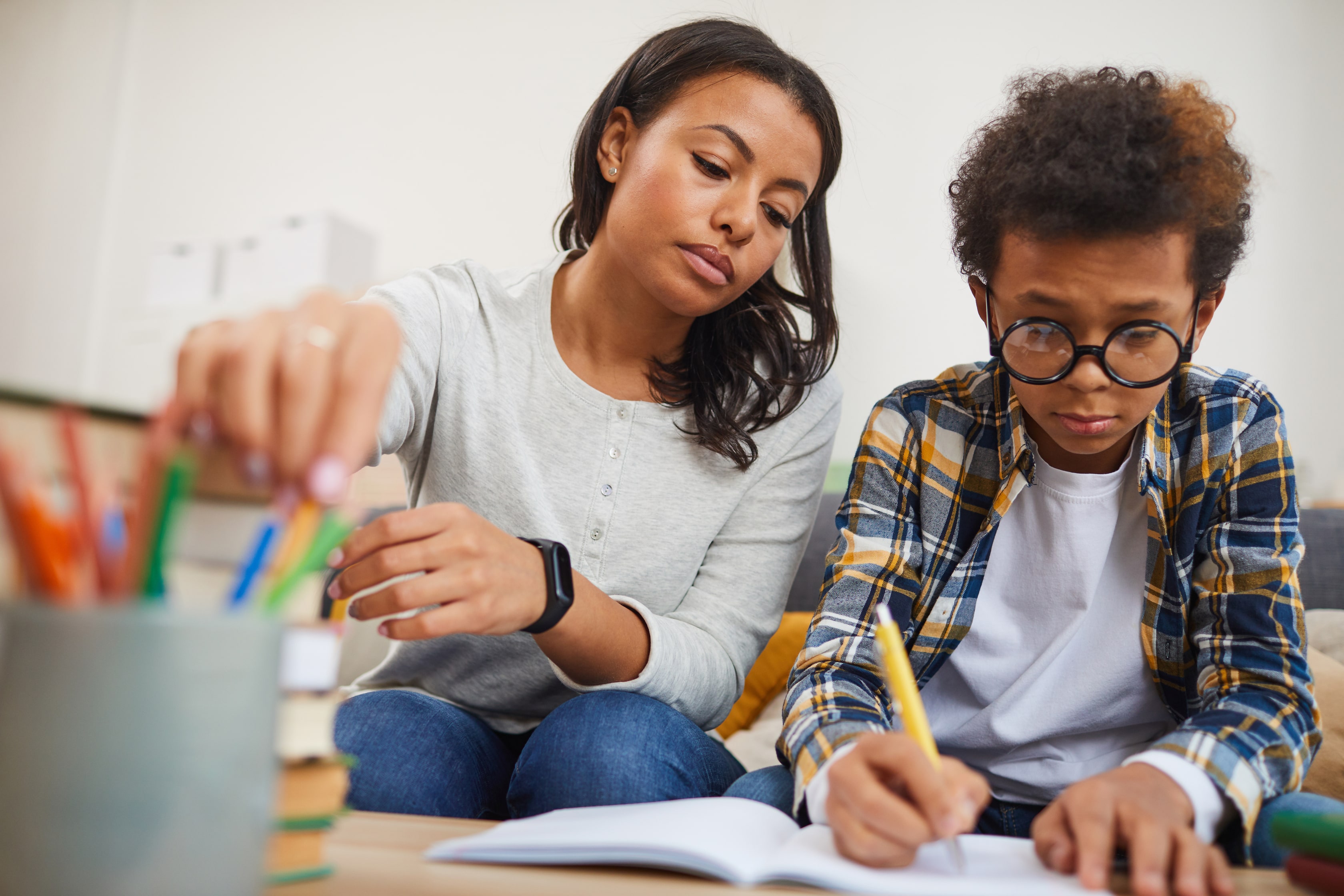Is Your Child Ready for First Grade Learning?

Grade one — what a milestone you and your child have reached together! It’s an exciting time full of learning and opportunities for growth. But with that comes the task of preparing for first grade.
Kids are expected to have a certain set of skills at every stage of the educational journey. You might be wondering if your child has the academic and social-emotional skills necessary to thrive in grade one, as well as what they’re expected to learn by the end of the year.
In kindergarten, many children acquire both academic and social skills through methods like play-based learning. When they start elementary school for the first time, your child will have to get used to a different classroom structure and learning schedule.
Scroll down to see what your child should know entering first grade, what they should learn by the end of the year and how you can help prepare your child for a fun and successful year. 👇
What should a child know entering first grade?

It’s important to recognize that what a child entering first grade should know will vary based on their previous school experience, especially since preschool and kindergarten aren’t always mandatory depending on the state or province in which you live.
Developing basic social skills during the early years is essential for success in first grade. Your child will be expected to know how to follow the rules of conversation, such as taking turns and listening to others when they’re speaking.
They’ll also be expected to know some basic academic skills in areas like math and literacy. Some of these include:
- Adding and subtracting numbers up to 10
- Counting the number of objects in a group
- Grouping objects to break up numbers up to 10
- Identifying people, places and things in a picture
- Answering questions about a passage or story their teacher reads
- Writing and differentiating between upper and lowercase letters of the alphabet
What first grade students learn by the end of the year

When they step out of kindergarten and into first grade, your child brings existing skills and acquires new foundational knowledge that will help them progress and succeed in second grade.
As a parent or guardian, you might think that your child is just practicing skills they already learned in kindergarten. But it’s important to remember that educators use first grade to help students further understand concepts and master skills. Try not to be too concerned about repetition right away.
We’ll get into more details below, but here’s a quick look at some of the benchmarks your child should have a grasp on at the end of first grade:
- Know right from left
- Read and write common sight words
- Work independently for short periods of time
- Try to write and spell new words phonetically
- Read aloud and understand first grade-level books
- Do addition and subtraction problems with numbers 0 to 20
- Write full sentences with correct capitalization and punctuation
- Tell time on analog and digital clocks to the nearest hour and half-hour
Readiness checklist for first graders
Remember: every child learns differently. So as you go through this checklist, treat it as a guideline — not the be-all and end-all of your child’s first grade experience.
Classroom and social skills
While many parents are rightly concerned about academic success, it’s important to also acknowledge the value of social emotional learning. In fact, nurturing these soft skills is a key aspect of the kindergarten curriculum. From playing with other children to sharing to actively listening, social skills aren’t just helpful in the classroom — they’re helpful in life.
- Joins in group activities
- Resolves conflicts using words
- Asks for adult help when necessary
- Adapts to change with relative ease
- Plays, shares and works with others
- Follows classroom rules and routines
- Uses materials with purpose and respect
- Shows eagerness and curiosity as a learner
- Respects others’ feelings and personal space
- Demonstrates self-confidence and a sense of self-worth
- Pays attention to a single task for an extended period of time
Math skills

In first grade math, your child’s teacher will cover different types of strategies for adding and subtracting numbers up to 20 (or more, depending on students’ skill levels). Your student will also learn things including how to tell time, sequencing, and measurements.
To help your child understand these concepts, their teacher will use teaching tools like number lines, clocks, dice, counters, ten frames, base ten blocks and unifix cubes.
Numbers, operations and problem-solving skills
- Writes numbers 0 to 20
- Names numbers 0 to 20
- Compares and classifies objects
- Uses counting skills to add to 10
- Uses lists or graphs to record and organize data
- Identifies, duplicates and extends various patterns
- Attempts to solve problems using manipulatives or their fingers
Geometry and measurement
- Knows how to identify, label and create various shapes
- Grasps and uses comparative words (e.g., heavy and light, long and short, big and little)
- Estimates and measures real quantities using non-standard units (blocks or paperclips)
- Familiarizes themself with common measuring instruments (e.g., rulers and thermometers)
Telling time and counting money
- Understands the calendar and time
- Knows the days of the week, months and year
- Knows how much a penny, nickel, dime and quarter are worth
Reading skills

You can expect your child to experience a lot of reading growth in first grade. They’ll practice things like growing their sight word vocabulary — i.e., words that don’t follow the rules of spelling or the six types of syllables like who, come or does — and retelling simple stories.
You can also expect regular spelling tests that aim to solidify their understanding and ability to write or read certain words.
- Retells a simple story
- Identifies basic sight words
- Associates letters and sounds
- Distinguishes fact from fiction
- Recognizes rhymes and rhyming patterns
- Recognizes all the letters of the alphabet in order
- Group common words (e.g., animals, shapes, colors)
- Recognizes words whether they’re spoken or written
- Knows and properly prints capital and lowercase letters
- Recognizes the who, what, when, where and why of a story
- Knows likenesses and differences of letter sounds in spoken words
- Uses pictures clues in text to identify words and construct meaning
- Spots a book’s title, author and illustrator name, and table of contents
- Starts understanding basic characteristics of stories, fables and legends
- Shares personal stories to express how they relate to characters or situations
- Predicts what will happen in a passage or story based on the title and pictures
- Builds understanding of punctuation marks (e.g., exclamations, questions and periods)
Writing skills

As your child’s reading skills improve, so will their first grade writing skills. While they enter first grade knowing how to read and write simple words, they’ll likely leave knowing how to write short sentences — with proper capitalization and punctuation, too!
- Handles writing utensils correctly
- Conveys messages by writing words
- Builds sentences with simple words
- Writes familiar words, including their name
- Depicts words or ideas using letters or shapes
- Progresses from left to right and top to bottom
Social studies skills
Your child might not recognize it right away but, in social studies, they’ll learn that their classroom is a microcosm of society. In first grade, students will work towards becoming better people as they learn about the rules and responsibilities of citizens, as well as how the world beyond their classroom works.
- Identifies and locates places using maps or globes
- Understands the concepts of past, present and future
- Knows significant individuals from their country’s history
- Recognizes their country’s symbols (e.g., national animal, flag)
- Knows holidays that commemorate people and historical events
- Knows, to some degree, about other cultures and cultural traditions
- Grasps history’s concept (i.e., a collection of real stories of past people, times, events and places)
- Recognizes communication methods from past to present day (e.g., oral, pictographs, mail, email, etc.)
Science skills

It might surprise you to know that first graders cover a few different types of science — physical, earth, life and environmental — building on scientific knowledge they learned in kindergarten.
In addition to scientific facts, your child’s teacher will also teach their first graders about the importance of observing, recording and sharing information.
- Identifies basic weather patterns
- Understands that all living things have basic needs
- Knows the difference between living and non-living things
- Recognizes how living things change as they grow and mature
- Recognizes different states of matter (i.e., solid, liquid and gas)
- Draws conclusions based on observations and exploration (i.e., experiments)
- Compares and describes the structural characteristics of plants and animals
- Recognizes how people impact the Earth (e.g., pollution, conservation and recycling)
- Knows the differences between types of environments (e.g., dry, wet, cold and hot) and their inhabitants
How to prepare my child for a better first grade
As a parent or guardian with a child entering first grade, one of the most important things they’ll need is a cheerleader.
There are some big structural differences as they transition from kindergarten to first grade. But with the tips below, you can help your child be successful.
1. Familiarize yourself with the first grade curriculum
Academic standards can vary quite a bit from state to state. While we’ve outlined some of the most important skills a first grader should learn, you can find the exact first grade curriculum on your state’s department of education website.
2. Be actively involved in your child’s education
Over 30 years of research has shown that parental involvement in education is the best indicator for student achievement. Parental involvement looks different in every household and the type of involvement needed will vary child to child.
We know that parents’ or guardians’ schedules can conflict, making involvement challenging. Depending on the schedules, it could look like:
- Leaving notes of encouragement in their lunch or school bags
- Helping your child with homework questions, or pointing them in the right direction
- Making sure your child has access to resources and sufficient learning tools (e.g., rulers, mobile devices, pencils, book and bookbags)
3. Take advantage of parent teacher conferences
Parent-teacher conferences are a great way to connect with your child’s teacher and go over your child’s progress. If there are any questions about their social or academic progress, their teacher should be able to answer them for you.
If there are any areas your child needs help with, a parent-teacher conference is a perfect way to come up with a plan that works best for your child. The teacher will appreciate it, too, because the information you provide can help them teach your child more effectively.
4. Align edtech programs with their curriculum
If your child uses any digital game-based learning programs, make sure they are standards-aligned. That way, their screen time can still be educational!
One of the reasons teachers use Prodigy Math Game in their curricula is because it’s an engaging app that contains math curriculum standards for students in 1st to 8th grade to practice as they play.
In Prodigy Math Game, your child creates a wizard and explores a fantastic world full of quests! Success in the game requires them to correctly answer standards-aligned math questions which adapt to their learning needs.
Plus, you can download the parent app and link your child’s account to see their math progress, send them motivating rewards and more!
Help your child thrive in math and English
Support your child as they discover a new learning journey with Prodigy.
Create your free account!
Preparing for first grade is possible
Everything we’ve shared looks like a lot of information, but children are like sponges. You’ll likely be amazed at how much they learn in first grade.
While your child works on mastering all those new skills, focus on the four tips above to help your child prepare for first grade. You’ll be glad you did!











